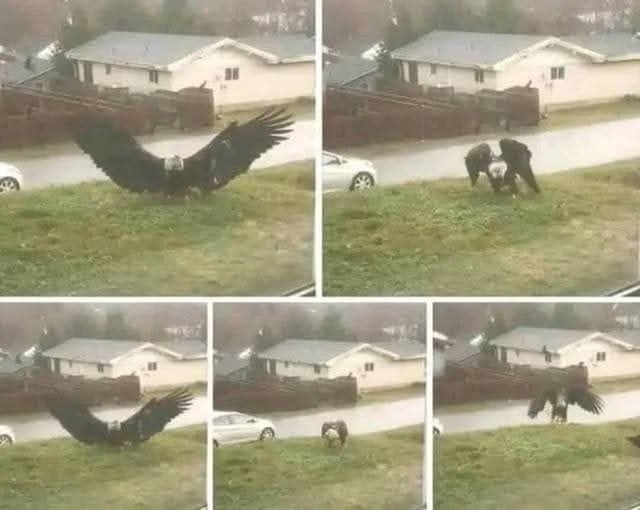It began like any other warm Texas morning — until a group of hikers stumbled upon something that would soon grip the world’s attention. In the remote woods near Brownsville, Texas, a shadow passed overhead that seemed too large to belong to any bird known to science. When the hikers looked up, what they saw made their hearts stop.
Perched on the branch of a tall mesquite tree was a creature out of myth — a massive eagle with golden eyes and a wingspan that stretched across the sky like a banner. Its feathers glimmered in the sunlight, and its talons gripped the branch like steel claws. For a long moment, no one spoke. It didn’t seem real.
The witnesses later described feeling both awe and fear. One of them whispered that it looked like “a thunderbird — the kind from ancient stories.” The bird turned its head slowly, scanning the horizon with a calm intelligence, as if aware it was being watched. Then, with one powerful motion, it took flight.
The air trembled as its enormous wings beat the wind. Leaves swirled, branches cracked, and the hikers could only stare in disbelief. Word spread quickly through Brownsville. Within hours, local wildlife experts, photographers, and reporters rushed to the area, hoping to witness the phenomenon themselves.
As the sun began to set, the bird was sighted again — gliding silently over the Rio Grande. Its shadow stretched across the ground like a moving storm cloud. Dozens of onlookers gasped, phones in hand, trying to capture proof of what seemed impossible.
Soon, state wildlife officers joined forces with conservationists to track the bird. Using drones and tranquilizer nets, they launched a careful, coordinated operation designed to capture it safely. After nearly half a day of tense effort, they succeeded.
The eagle was caught unharmed, resting now in the hands of experts who could hardly believe their eyes. With a wingspan estimated at nearly 10 feet and a body mass unlike any known eagle, the creature defied all classification. The team cheered as they realized they had secured one of the most extraordinary wildlife finds in modern history.
The eagle was carefully transported to a wildlife research facility in South Texas. There, it was placed in a specialized habitat where veterinarians and ornithologists could study it. Early examinations confirmed it was in good health — though slightly dehydrated from the chase.
Scientists immediately began genetic testing. Could this be a massive golden eagle? A hybrid? Or something entirely new — a species lost to time, resurfacing from an ancient lineage thought extinct?
Initial results suggested that the bird had features unlike any recorded eagle. Its bone structure, feather density, and talon length all seemed beyond the known biological range. Some experts speculated it might be a relict species from the Pleistocene era, surviving undetected in remote wilderness regions.
Others urged caution, reminding the world that nature can surprise us in ways that mimic legend. Until genetic data was fully verified, no official classification would be made. Still, whispers of “the thunderbird” began to circulate online, blending science and myth in viral fascination.
News outlets worldwide picked up the story. Photos of the captured eagle spread across social media like wildfire. People from as far as Japan and Brazil expressed astonishment, calling it “the find of the century.” Scientists flooded the Texas Wildlife Department with offers to assist in research.
Brownsville, once a quiet border town, became a global point of intrigue. Locals expressed pride, saying their small community had become home to a piece of natural history. Hotels filled with visitors hoping to learn more, while conservationists urged respect for the bird’s privacy.
Environmental groups quickly joined the discussion. Could climate change or habitat disruption have driven this creature into human sight? Or had it simply been hidden in remote canyons, waiting to be discovered?
Amid the excitement, one thing became clear: this eagle had reignited humanity’s awe for the mysteries of the natural world. Scientists debated, locals celebrated, and the internet buzzed with theories — from prehistoric survivors to government secrets.
As researchers continued their work, they confirmed that the bird’s behavior was remarkably calm and intelligent. It appeared unafraid of humans, responding to gentle movement and maintaining steady eye contact, as though it understood it was being studied.
Officials from the U.S. Fish and Wildlife Service and the Audubon Society soon arrived to verify the find. Their statements were cautious but hopeful: “If confirmed as a new species,” one said, “this discovery could reshape our understanding of raptor evolution.”
For now, the eagle remains under close observation in a protected facility. Plans are being considered for eventual release into a secure wildlife reserve once studies are complete. The goal is to preserve its well-being above all else.
Meanwhile, locals gather nightly near the woods where it was found, gazing at the darkening sky, half-expecting to see another one take flight. “It’s like nature reminding us she still has secrets,” one elderly resident said softly.
The story of the Brownsville eagle continues to unfold — somewhere between science and legend, reality and wonder. Whether it proves to be a new species or an extraordinary variant of one already known, the message is clear: the wild still holds mysteries that defy imagination.
And perhaps, in that vast stretch of Texas wilderness, the giant eagle was never truly lost — only waiting for us to remember that not everything powerful and beautiful has yet been discovered.
